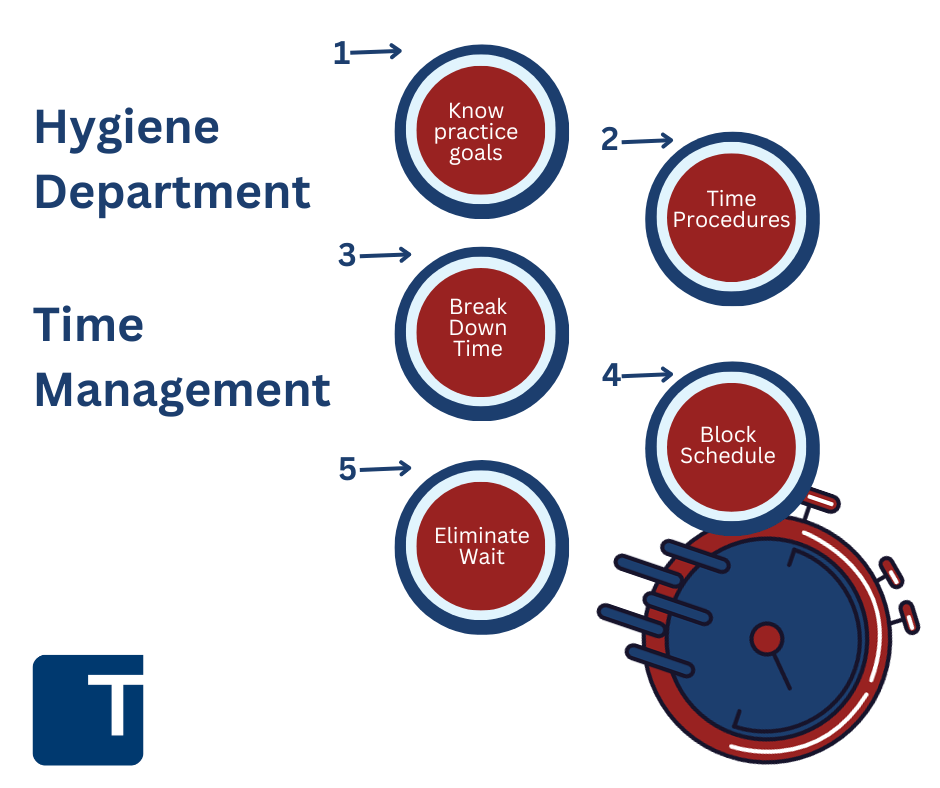Originally published December 2016 in Trojan Today.
Effective time management is of utmost importance in every dental practice. It is important for dental hygienists to effectively manage each patient. Without managing your schedule, you are sure to experience many stressful days which may lead to burnout.
The dental hygiene appointment can be stress-free if you follow these steps:
Know the Practice Goals
Know the office production goals. Be familiar with the latest technology in order to treat patients effectively. Understand what will save you time as a clinician.
Time Your Procedures
Assess exactly how much time you spend seating, greeting, collecting patient data, treating your patients, dismissing patients, etc. Time each of your types of appointments from the time you greet your patient until the time you dismiss your patient.
Write down how much time you need for each type of hygiene patient appointment.
It’s important to block your schedule using 10-minute increments. If you choose 15 minutes, you will lose thousands of dollars over a year of appointments.
Break Down the Time
An example of how to break down a 60-minute prophylaxis appointment is to use these 5 areas:
- Data Collection
- Treatment Planning/Case Acceptance
- Patient Treatment
- Hygiene/Doctor Exam
- Patient Dismissal/Room Breakdown/Set-up.
List the various types of hygiene patients you see. For example:
- Prophylaxis
- Perio Therapy/Scaling and Root Planing
- New Patients
- Children 13-17
- Children under 12
- Etc.
Once you have your list of the types of patient appointments, list the five blocks of time using the data collection, treatment planning/case acceptance, treatment, including time for the hygiene/doctor exam, and then a time for dismissal and room turn-around.
An example of this list, for Prophylaxis Patient, may be:
Prophylaxis Patient
- Data Collection – 7 minutes
- Treatment Planning/ Case Acceptance – 7 minutes
- Treatment – 30 minutes
- Hygiene/ Doctor Exam – 7 minutes
- Dismissal/ Room Turnaround – 7 minutes
In this example, with sixty minutes given to the hygienist, you would have two minutes left to write your patient notes before you actually dismiss your patient. There will never be a perfect scenario but the doctor and other team members should be able to look at a clock and know where the hygienist is in the patient appointment.
This will be helpful for the doctor’s assistant in getting the doctor into the hygiene room at the appropriate time to complete the hygiene patient exam.
Think outside the box of blocking hygiene appointments for exactly 60 minutes. Some patients may only need 50 minutes, younger children may need 40 minutes, and many perio therapy patients might have two quadrants of scaling and root planing completed in one 90-minute appointment versus two 60-minute appointments on different days.
If you use a hygiene assistant, be sure to block out the assistant’s time as well.
Use a Schedule with Blocked Templates
Once you have established your daily production goal for each treatment room, work with your team to create and visually lay out a hygiene schedule that will be patient-centered, providing quality care and that personal touch.
An example of blocking your perfect day’s schedule may be to see perio therapy appointments first part of your day and new patients before or after lunch. Possibly you want to have those routine prophylaxis or periodontal maintenance appointments at the end of the day. Block out the patient services when you are most comfortable seeing these types of patients. If you are more energetic in the morning, plan to see the more difficult patients: Periodontal therapy/scaling and root planing, longer appointments for new patients, etc.
Eliminate the Wait
Once you have collected your patient data, show your patient what you see in their mouth. Until the treatment planning/case acceptance phase, you have been the detective; now it’s time to collaborate with your patient to create a plan of treatment. After you have come to an agreement on the patient treatment plan, even if it is only a six-month prophylaxis appointment, the hygienist can begin the actual scaling procedure.
At any point forward, doctor can be directed into the hygiene room to complete the patient exam. There is never a need to wait for the scaling or polishing to be complete in order for doctor to complete the patient exam. For years there’s been the mindset that doctor can’t examine until the patient’s teeth are clean. Times have changed and hygienists are not in the business of cleaning teeth but in the business of creating optimal health for the entire body.
Waiting for doctor to complete the patient exam never be left until the very end. Everyone ends up waiting; hygienists run behind and the vicious cycle of running on a treadmill continues.
Remember:
- Organize the various patient appointments
- Get the team onboard with the process
- Never have doctor wait until the end of a hygiene appointment to complete the exam
- Think outside the box when creating your perfect day’s schedule
Effective time management skills will allow you to step off that treadmill and enjoy a career in dentistry. The “Down to a Science Time Management Formula” is one system that will create a day of Zen, not a day of stress.
Debbie Seidel-Bittke, RDH, BS, is founder of Dental Hygiene Solutions, Powered by Dental Practice Solutions. You can grab her no cost 3-Part Hygiene Department Video Training today.
FMI: 949-351-8741
Read more from Debbie Seidel-Bittke:

